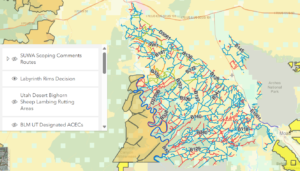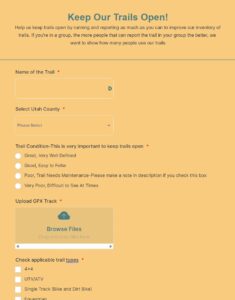Manti LaSal Forest Management Plan Comments Due by November 16
The Forest Service has released their draft plan for the Manti LaSal Forest. The Manti LaSal forest is in Northern Utah near Manti, and also in the LaSal Mountains in Colorado east of Moab. It makes up 1.4 Million acres in total. It is home to both the Arapeen Trail System as well as some of the best snowmobiling areas in Utah.
The plan has potentially devastating impacts on winter recreation, substantial cutbacks in motorized vehicle areas, and proposes 7 areas to be considered Wilderness areas.
REMEMBER: When submitting comments, the most important ones, and the hardest for us to get, are details on the trails you use. Include photos and Forest Service Road Numbers if you know them, Please get your comments sent in one of the 3 ways before November 16.
BlueRibbon Coalition will be publishing comments on the plan, but we need your comments as well, especially those concerning how you, or your family, has used the area, what trails, what time of year, forms of recreation, any access issues like disabilities, etc. You can learn more about the details and submit comments on BRC’s Action Alert here.
Visit the Forest Service Project Page and Submit Comments Directly to the Forest Service Here. Suggested tip, hopefully you will have long strings of comments, photos, and more. These are most easily submitted by writing them in a document and attaching them rather than using the form box.
UPLA received comments from the San Pete Tourism Office which are copied below that you might use as a basis for your own comments.
WINTER RECREATION AND ACCESS
GUIDELINES (FW-WINTER-GD) – PAGE 2-60
02 TO MANAGE FOR AND PROVIDE A DIVERSITY OF WINTER RECREATION OPPORTUNITIES, MOTORIZED, OVER-SNOW TRAVEL IS NOT SUITABLE IN PRIMITIVE AND SEMI-PRIMITIVE NON-MOTORIZED RECREATION OPPORTUNITY SPECTRUM CLASSES EXCEPT FOR EMERGENCIES OR ADMINISTRATIVE USES. NEW MOTORIZED FACILITIES AND INFRASTRUCTURE SHOULD NOT BE DEVELOPED IN THOSE CLASSES.
Motorized over-snow travel is suitable in primitive and semi-primitive non-motorized recreation opportunity spectrum classes, as the landscape is protected by a layer of snow. No evidence of over-snow travel remains after the snow melts. Also, the more over-snow machines spread out, the lower the impact on wildlife, and the less conflict with non- motorized users that tend to recreate close to trailheads.
RECREATIONAL OPPORTUNITIES SPECTRUM, NORTH ZONE
Summer ROS: no semi-primitive non-motorized areas should be designated in the Sanpete Ranger District. Alternative A is the preferred option for the north zone.
Winter ROS: no semi-primitive non-motorized areas should be designated- except on big game winter range.
RECOMMENDED WILDERNESS MANAGEMENT AREA
No areas on the north zone should be considered as wilderness, specifically:
1. Blind canyon
2. Mill fork
3. Fish creek
4. Candland mountain
5. Gentry mountain
6. Canal canyon
7. Sanpitch
Nor should the following standards, objectives, & guideline be practiced for the north zone. Such practices essentially allow the land to be managed as wilderness without congressional approval.
OBJECTIVES (MA-RECWILD-OB) – PAGE 4-95
01 TO ENSURE MAINTENANCE OF THE WILDERNESS CHARACTERISTICS THAT COULD ALLOW THESE AREAS TO BE ADDED TO THE WILDERNESS SYSTEM, CLOSURE ORDERS FOR COMMERCIAL FILMING AND LAUNCHING SHOULD BE WRITTEN WITHIN FIVE YEARS OF PLAN APPROVAL.
02 OVER THE LIFE OF THE PLAN, REQUEST THAT ALL RECOMMENDED WILDERNESS AREAS BE WITHDRAWN FROM MINERAL ENTRY IN CONFORMANCE WITH SECTION 204 OF THE FEDERAL LAND POLICY AND MANAGEMENT ACT OF 1976 (NATIONAL FOREST MANAGEMENT ACT OF 1976).
STANDARDS (MA-RECWILD-ST)
01 COMMERCIAL FILMING SHALL NOT BE AUTHORIZED IN RECOMMENDED WILDERNESS AREAS.02 RECREATION OPPORTUNITIES SHALL BE CONSISTENT WITH THE RECREATION OPPORTUNITY SPECTRUM CLASSIFICATION OF PRIMITIVE.
03 RECOMMENDED WILDERNESS AREAS SHALL NOT BE SUITABLE FOR TIMBER PRODUCTION.
04 TIMBER HARVEST IN A RECOMMENDED WILDERNESS AREA SHALL ONLY OCCUR IF REQUIRED TO MAINTAIN THE WILDERNESS CHARACTERISTICS OF THAT AREA.
05 RECOMMENDED WILDERNESS AREAS SHALL BE SUITABLE FOR WATERSHED RESTORATION ACTIVITIES WHERE THE OUTCOMES WILL PROTECT THEIR WILDERNESS CHARACTERISTICS, IF THE ECOLOGICAL AND SOCIAL CHARACTERISTICS THAT PROVIDE THE BASIS FOR WILDERNESS RECOMMENDATION ARE MAINTAINED AND PROTECTED.
06 RECOMMENDED WILDERNESS AREAS SHALL NOT BE SUITABLE FOR MOTORIZED AND MECHANIZED TRANSPORT, UNLESS FOR EMERGENCY SERVICES, VALID EXISTING RIGHTS, OR ADMINISTRATIVE USE.
07 RECOMMENDED WILDERNESS AREAS SHALL NOT BE SUITABLE FOR NEW MOTORIZED OR MECHANIZED ROADS OR TRAILS.
08 SCENERY MANAGEMENT SHOULD BE CONSISTENT WITH THE SCENIC INTEGRITY OBJECTIVE OF HIGH OR VERY HIGH. GUIDELINES (MA-RECWILD-GD)
01 TO MAINTAIN WILDERNESS CHARACTERISTICS, FIRE SUPPRESSION ACTIONS SHOULD APPLY MINIMUM IMPACT STRATEGIES AND TACTICS, EXCEPT WHEN DIRECT ATTACK IS NEEDED TO PROTECT LIFE, ADJACENT PROPERTY, OR TO MITIGATE RISKS TO RESPONDERS.
02 TO ENHANCE OR IMPROVE WILDERNESS CHARACTERISTICS, VEGETATION MANAGEMENT ACTIONS SHOULD BE UNDERTAKEN USING THE MINIMUM TOOLS AND TECHNIQUES NECESSARY.
03 TREE CUTTING MAY OCCUR INCIDENTAL TO OTHER MANAGEMENT ACTIVITIES, SUCH AS TRAIL CONSTRUCTION, TRAIL MAINTENANCE, REMOVAL OF HAZARD TREES, OR FIRELINE CONSTRUCTION.

